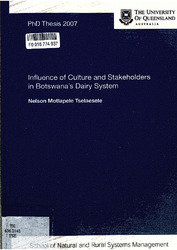| dc.description.abstract | ABSTRACT
The government of Botswana initiated dairy industry development in the early 1980’s to reduce the
country’s dependence on milk imports from neighbouring countries, particularly South Africa and
Zimbabwe. The other objectives of dairy development were to diversify the economy away from
mineral revenue and the traditional agricultural activities of beef cattle farming and subsistence
rain-fed arable production, and to reduce rural - urban migration by employment creation in rural
areas. The Government created a fund under a Financial Assistance Policy, which assisted
prospective dairy farmers with a grant-loan scheme that provided up to 85 % grant with the balance
as a loan depending on remoteness of the farm. The policy deliberately favored women’s
empowerment by awarding a higher grant to female applicants.
An evaluation of the dairy industry in 2000 reported that it was not performing up to planned
expectations, especially, with respect to dairy cow management. It was reported that dairy farmers
were equating the management of dairy cows to that of beef cattle by letting the cows travel long
distances foraging in the bush with no supplementary feed given to them. This poor cow
management resulted in low milk output per cow, a high number of dry cows and high calf
mortality. These problems provided the foundation for this research.
The thesis of this research is that during the planning stages of government projects such as dairy
industry development policy, much emphasis is placed on the economic and technical viability as
success factors, while the importance of culture is overlooked. I argue that, the success of project
implementation should be considered as part of a system which includes cultural factors and the
influences of many stakeholders.
The main objective of the research was to understand how dairy farmers in Botswana combined the
technical and economic management systems advocated in national policy with management
approaches inspired by cultural knowledge and experience; to identify why dairy farmers find it
expedient to infuse cultural management approaches into their farm management systems.
Systems theory was used to understand the state of dairy farming systems in Botswana. A theory on
stakeholder analysis was used to complement systems analysis because farming systems are also
human activity systems. Therefore, an understanding of individuals and institutions that impact on
dairy farming system is necessary to be viewed from the farmers’ perspective. A constructivist
epistemology with a phenomenological methodology using interviews and observations were used
to collect data from four sites in Botswana comprising, two peri-urban areas and two rural areas
The research indicates that in situations where technical dairy knowledge was lacking or not easy to
implement because of economic constraints, farmers relied heavily on cultural knowledge and
practices derived from customary beef cattle fanning. In addition farmers received a great deal of
influence from stakeholders at different stages of dairy production, reinforcing both technical and
cultural practices in varying ways.
The study concludes that fanners depended a great deal on cultural knowledge to manage their
farms, owing to insufficient knowledge of dairy farming practices, caused by inadequate farmers
support services to handle demands from the introduced dairy fanning systems. There was thus a
mismatch between government intentions and farmers’ realities complicated further by stakeholder
influences. | en_US |

